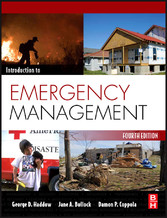Suchen und Finden
Service
Introduction to Emergency Management
George Haddow, Jane Bullock, Damon P. Coppola
Verlag Elsevier Reference Monographs, 2010
ISBN 9781856179607 , 424 Seiten
4. Auflage
Format PDF, ePUB, OL
Kopierschutz DRM
Front Cover
1
Introduction to Emergency Management
4
Copyright Page
5
Contents
8
Foreword
14
Acknowledgments
16
Introduction
18
Chapter 1. The Historical Context of Emergency Management
22
What You'll Learn
22
Introduction
22
Early History: 1800–1950
23
The Cold War and the Rise of Civil Defense: the 1950s
24
Changes to Emergency Management: the 1960s
25
The Call for a National Focus on Emergency Management: the 1970s
26
Civil Defense Reappears as Nuclear Attack Planning: the 1980s
29
An Agency in Trouble: 1989–1992
30
The Witt Revolution: 1993–2001
31
Terrorism: 2001
33
The Steps Leading to the Katrina Debacle
41
Post-Katrina Changes
41
The Future Environment of Emergency Management
44
Important Terms
47
Self-Check Questions
47
Out-of-Class Exercise
48
Chapter 2. Natural and Technological Hazards and Risk Assessment
50
What You Will Learn
50
Introduction
50
Natural Hazards
51
Technological Hazards
72
Chemical
77
Biological
77
Radiological
78
Nuclear
79
Hazards Risk Management
80
Risk Management Technology
83
Social and Economic Risk Factors
83
Conclusion
85
Important Terms
86
Self-Check Questions
87
Out-of-Class Exercises
88
Chapter 3. The Disciplines of Emergency Management: Mitigation
90
What You'll Learn
90
Introduction
90
Mitigation Tools
91
Hazard Identification and Mapping
94
Impediments to Mitigation
104
Federal Mitigation Programs
105
The National Earthquake Hazard Reduction Program
112
Nonfederal Mitigation Grant Programs
114
Conclusion
114
Important Terms
115
Self-Check Questions
115
Out-of-Class Exercises
115
Chapter 4. The Disciplines of Emergency Management: Preparedness
118
What You'll Learn
118
Introduction
118
A Systems Approach: The Preparedness Cycle
119
Mitigation versus Preparedness
123
Preparedness: The Emergency Operations Plan
123
Education and Training Programs
128
Emergency Management Exercises
132
Evaluation and Improvement
135
Preparedness: A National Effort
137
Preparedness Grant Programs
139
Business Continuity Planning and Emergency Management
142
Conclusion
144
Important Terms
151
Self-Check Questions
151
Out-of-Class Exercises
151
Chapter 5. The Disciplines of Emergency Management: Communications
154
What You'll Learn
154
Introduction
154
The Mission
155
Audiences/Customers
160
Communicating in the Era of Homeland Security
161
Disaster Communications in a Changing Media World
163
Building an Effective Disaster Communications Capability in a Changing Media World
172
Creating Effective Disaster Communications
172
Conclusion
183
Important Terms
184
Self-Check Questions
184
Out-of-Class Exercises
184
Chapter 6. The Disciplines of Emergency Management: Response
186
What You'll Learn
186
Introduction
186
Local Response
192
State Response
193
Volunteer Group Response
194
Incident Command System
196
The Federal Response
199
Federal Assistance
206
Key Federal Response Officials
224
Other FEMA Response Resources
227
The Emergency Management Assistance Compact (EMAC)
230
Conclusion
231
Important Terms
232
Self-Check Questions
232
Out-of-Class Exercises
233
Chapter 7. The Disciplines of Emergency Management: Recovery
234
What You'll Learn
234
Introduction
234
The National Response Framework for Disaster Recovery Operations
241
FEMA's Individual Assistance Recovery Programs
247
FEMA's Public Assistance Grant Programs
253
Other Federal Agency Disaster Recovery Funding
257
Recovery Planning Tools
261
Long-Term Recovery Planning Annex
262
Community Long-Term Recovery Planning
264
Conclusion
266
Important Terms
270
Self-Check Questions
271
Out-of-Class Exercises
271
Chapter 8. International Disaster Management
272
What You'll Learn
272
Introduction
272
Disasters in Developing Nations
273
International Disasters
273
Important Issues Influencing the Response Process
274
The United Nations System
277
The United Nations Office for the Coordination of Humanitarian Affairs
282
Nongovernmental Organizations
291
Assistance Provided by the U.S. Government
296
Conclusion
316
Important Terms
316
Self-Check Questions
316
Out-of-Class Exercises
317
Chapter 9. Emergency Management and the Terrorist Threat
318
What You'll Learn
318
Introduction
318
Changes in Emergency Management and the War on Terrorism
319
September 11, 2001
322
Federal Government Terrorism Activity
328
The 911 Commission
344
State Government Terrorism Activity
348
Local Government Terrorism Activity
350
The Effect of Hurricane Katrina on Terrorism Preparedness and Response
352
Conclusion
359
Important Terms
360
Self-Check Questions
360
Out-of-Class Exercises
361
Chapter 10. The Future of Emergency Management
362
Understanding the Past
362
The Obama Administration
365
"Those Who Forget the Past Are Doomed to Repeat It"
365
Emergency Management Ideas for the Future
368
Conclusion
374
Appendix A: Acronyms
376
Appendix B: Emergency Management Websites
382
Appendix C: Ready.gov Citizen Preparedness Recommendations
386
Appendix D: A Day in the Life of Homeland Security
394
Glossary
398
A
398
B
398
C
398
D
398
E
399
F
399
H
399
I
400
J
400
L
400
M
400
N
400
P
401
R
401
S
401
T
401
U
401
V
401
W
401
Z
401
References
402
Index
408
A
408
B
408
C
409
D
410
E
411
F
412
G
413
H
414
I
415
J
416
K
416
L
416
M
416
N
417
O
419
P
419
Q
420
R
420
S
421
T
422
U
422
V
423
W
423
Y
423
Z
423



















